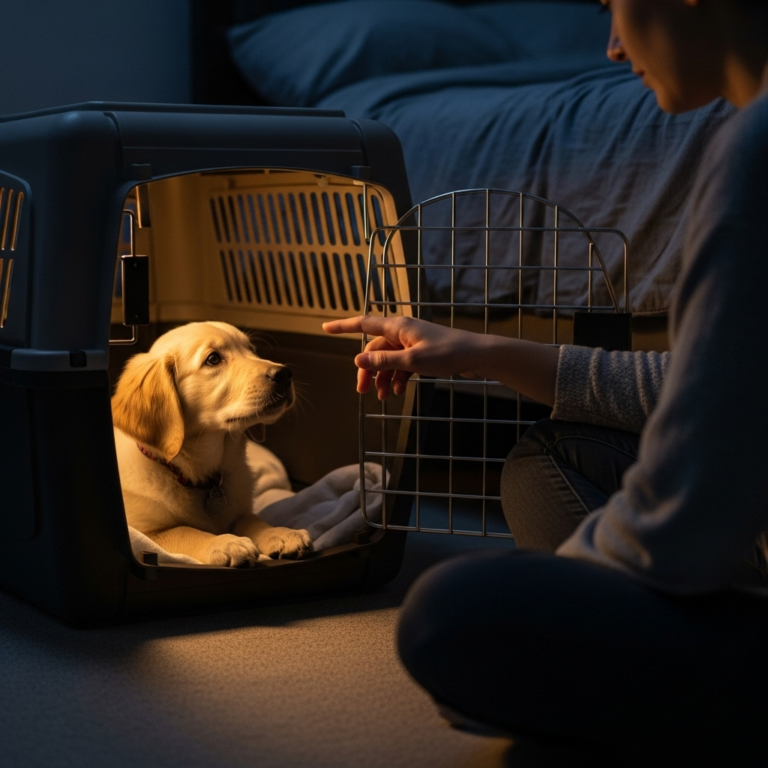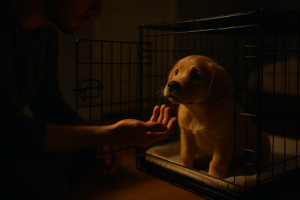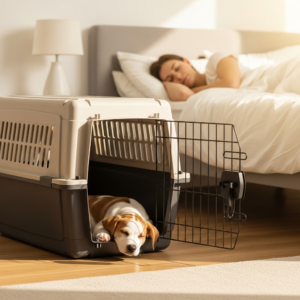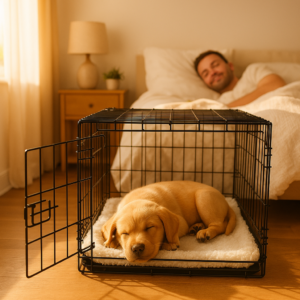If you’re desperately searching for what to do when a puppy cries at night, let me start by saying: I see you, and I’ve been there. I remember the exact moment the panic set in. It was 2 a.m., and the high-pitched, relentless crying from the crate next to my bed had been going on for what felt like an eternity. My new Golden Retriever puppy, Max, was utterly beside himself, and frankly, so was I. I was bone-tired, my nerves were frayed, and a wave of guilt washed over me. “Am I doing this wrong? Is he scared? Does he hate his new home?” Every piece of advice I’d read swirled in my exhausted brain. This guide is my promise to you. It will empower you with a step-by-step, compassionate plan to transform your puppy’s nighttime fear into confidence, bringing peace and a full night’s sleep back to both of your lives.
Contents
- 1 First, Let’s Understand What’s Really Happening (The “Why”)
- 2 The Telltale Signs: Is It Normal Puppy Crying or Something More?
- 3 The Foundation: Creating a “Safe & Secure” Environment
- 4 The Core Treatment Plan: A Step-by-Step Desensitization Protocol
- 5 Tools and Aids That Can Help (But Aren’t a Magic Fix)
- 6 Common Mistakes to Avoid (What I’ve Learned the Hard Way)
- 7 Frequently Asked Questions (The Expert Answers)
- 8 Your Journey to Peaceful Goodbyes
First, Let’s Understand What’s Really Happening (The “Why”)
Before we dive into the “how,” it’s crucial to understand the “why” behind your puppy’s cries. It’s not manipulation or bad behavior; it’s a genuine expression of distress.[1][2] Think about it: just days ago, your puppy was snuggled up with their mom and littermates, a warm, breathing, familiar pile of comfort.[3] Now, they’re in a new place with strange smells and sounds, and they are utterly alone for the first time in their lives.[1][4] It’s a scary transition!
A puppy’s crying at night is often a combination of:
-
Separation Anxiety: This is the most common reason.[1] They are social animals hardwired to feel safe in the company of their family.[1][4] Being alone is frightening.[5]
-
Basic Needs: A tiny bladder means they may genuinely need a potty break.[1][6] They might also be hungry, thirsty, or too hot or cold.[1][7]
-
Fear of a New Environment: New sights, sounds, and smells can be overwhelming for a young pup.[1]
It’s helpful to think of it like a panic attack for your dog. Their crying is an instinctual call for help, a way of saying, “I’m scared! Where is everyone?”[2][4] Ignoring that cry, especially in the first few weeks, can increase their anxiety and may lead to more significant behavior problems down the road.[5][8] Our goal isn’t to silence the crying but to address the underlying fear.
The Telltale Signs: Is It Normal Puppy Crying or Something More?
While some nighttime crying is normal for a new puppy, it’s important to distinguish it from a more severe issue like separation anxiety.[9] Generally, a puppy settling into a new home will cry less and less over the first week or two.[10][11]
Here’s a simple checklist to help you gauge the situation:
-
Mild (and Normal):
-
Moderate (Needs Management):
-
Crying persists for more than 15-20 minutes at a time.[12]
-
The crying doesn’t seem to be improving after the first week.
-
Your puppy seems generally anxious, even during the daytime.
-
-
Severe (Potential Separation Anxiety):
If you’re seeing signs in the severe category, it’s wise to consult with a veterinarian or a certified animal behaviorist.[13][14]
The Foundation: Creating a “Safe & Secure” Environment
The first step to peaceful nights is creating an environment that screams “safety” to your puppy. A predictable routine is your best friend here.[15] Dogs thrive on knowing what to expect.[16]
The Power of the “Safe Haven”
Properly introducing a crate is a game-changer. Think of it not as a cage, but as your puppy’s personal den—a safe, cozy space that belongs only to them.[17][18]
-
Location, Location, Location: For the first few weeks, the crate should be in your bedroom, right next to your bed.[5][19] This is non-negotiable. Your presence is incredibly reassuring. They can smell you, hear you breathe, and won’t feel so alone.[3]
-
Make it Comfy: The crate should be just big enough for them to stand up, turn around, and lie down comfortably.[1][2] Furnish it with soft bedding and consider adding a “Snuggle Puppy” toy, which has a battery-powered heartbeat and a pouch for a heat pack to mimic a littermate.[16][19] An old t-shirt that smells like you can also be very comforting.[20][21]
-
Positive Association: Never use the crate as punishment.[1][22] During the day, make it a wonderful place by feeding them their meals in it and tossing in high-value treats for them to discover.[16]
The Role of Exercise and Mental Stimulation
I live by the motto: “A tired puppy is a good puppy.” This is especially true at night. A pup with pent-up energy will have a much harder time settling down.[3]
-
Physical Exercise: Engage in age-appropriate play sessions in the evening. A game of fetch or a gentle walk can work wonders.[16]
-
Mental Stimulation: Don’t forget to tire out their brain![3] Short, fun training sessions or puzzle toys that make them work for their food are fantastic for this.[16][20] Licking and chewing are naturally calming activities for dogs, so giving them a frozen KONG stuffed with their dinner about an hour before bed can help them wind down.[16]
The Core Treatment Plan: A Step-by-Step Desensitization Protocol
This is where your patience and consistency will truly pay off. We want to teach your puppy that being alone at night is no big deal.
Phase 1: The “No-Fuss” Potty Break
When your puppy cries in the middle of the night, your first assumption should be that they need to go potty.[3][6] Young puppies simply can’t hold it all night.[6]
-
The Mission: When they cry, calmly and quietly take them out of the crate on a leash.[3]
-
Keep it Boring: This is not playtime.[3] Use a calm, quiet voice. Don’t get excited or chatter with them.[3][8] Take them directly to their designated potty spot.
-
Praise and Return: The moment they finish their business, give them quiet praise (“Good potty!”) and immediately bring them back to the crate.[3]
-
The “No-Big-Deal” Rule: Settle them back in with minimal fuss and then return to your bed.[3] This teaches them that crying gets them a functional trip outside, not a party.
Phase 2: The Comforting Presence
The beauty of having the crate next to your bed is that you can offer comfort without even getting up.
-
The Finger Sniff: When Max would start to whimper, I’d simply stick my fingers through the crate door. He’d sniff and lick them, and just knowing I was right there was often enough to help him settle back to sleep.[12]
-
Soothing Sounds: Speak to them in a soft, low voice. A quiet “Shh, it’s okay” can be very reassuring.[7] Some puppies also find white noise machines or soft classical music calming.[20][21]
Phase 3: Slowly Increasing the Distance (When They’re Ready)
Only after your puppy is consistently sleeping through the night in your room for at least a week should you consider moving the crate.
-
Inch by Inch: Don’t make a sudden move to the living room. Move the crate a few feet away from your bed each night.[3][23] Then to the doorway, then just outside the door, and so on, until it’s in its final desired location. This gradual process prevents them from feeling the separation so acutely.[23]
My Personal “Game Changer” Tip
The one thing that made the biggest difference for Max was creating a very specific bedtime routine. About 30-60 minutes before we went to sleep, all exciting play would stop.[15][24] We’d dim the lights, I’d give him a chew toy to help him relax, and we’d have a final, calm potty break.[16][20] This routine signaled to him that the day was ending and it was time to wind down.[7][15] It became a powerful, predictable cue for sleep.
Tools and Aids That Can Help (But Aren’t a Magic Fix)
While there’s no substitute for compassionate training, some tools can support your efforts:
-
Calming Pheromone Diffusers: Products like Adaptil release a synthetic version of the pheromone a mother dog produces to calm her puppies.[16][20] Placing a diffuser near the crate can help create a sense of security.[25]
-
Puzzle Toys: As mentioned, food-dispensing toys provide excellent mental stimulation and can keep a puppy occupied if they wake up.[3][20]
-
Anxiety Vests: While more commonly used for thunderstorms or travel, a gentle pressure wrap can have a calming effect on some dogs.
-
Heartbeat Toys: A soft toy that emits a rhythmic “heartbeat” can simulate the comfort of a littermate.[19][20]
Common Mistakes to Avoid (What I’ve Learned the Hard Way)
We all make mistakes, but avoiding these common pitfalls will make your journey much smoother.
-
Mistake #1: Punishing the dog. Never, ever yell at or punish your puppy for crying.[1] This will only increase their fear and anxiety and can severely damage your bond.[26]
-
Mistake #2: Letting them “cry it out.” While it’s okay to wait a moment to see if they’ll self-soothe, letting a genuinely distressed puppy cry for extended periods can lead to a feeling of learned helplessness, where they stop crying not because they’re calm, but because they’ve learned no one is coming to help.[2][5][8]
-
Mistake #3: Turning nighttime into playtime. Keep nighttime interactions brief and boring.[3] You want to reinforce that nighttime is for sleeping.
-
Mistake #4: Moving too fast. Be patient. Every puppy is an individual.[21] Don’t rush moving the crate or expecting them to sleep a full eight hours by the end of the first week.
Frequently Asked Questions (The Expert Answers)
Can this nighttime crying be cured completely?
Yes, for the vast majority of puppies, this is a temporary phase that resolves with patience and consistent training.[1] They learn the routine and gain confidence.
How long will this training take?
It varies, but most puppies start to settle in and cry significantly less within the first week or two.[1][10][11] By the time a puppy is around 4 months old, many are able to sleep through the night.[1][18]
Should I get another dog to help with loneliness?
While some puppies do settle better with another animal in the home, getting another dog is a huge commitment and should not be seen as a quick fix for nighttime crying.[26][27] It can also lead to other challenges.
When should I consider consulting a professional?
If the crying is severe, isn’t improving after a couple of weeks, or is accompanied by other signs of intense distress like destructive behavior or self-harm, it’s time to call a veterinarian to rule out medical issues or a certified professional dog trainer or behaviorist for help.[1][13]
Your Journey to Peaceful Goodbyes
The journey from sleepless, stressful nights to quiet, peaceful ones is a testament to the bond you are building. It’s a process built on patience, understanding, and love. Remember Max, my little howling retriever? Within a couple of weeks of sticking to our compassionate routine, the crying stopped. He learned he was safe, he learned the routine, and he learned that nighttime was for sleeping. He grew into a confident, secure dog, and our bond was stronger for it.
You will get there too. Be kind to your puppy, but also be kind to yourself. You are doing a great job. By meeting your puppy’s needs with empathy and consistency, you are laying the foundation for a lifetime of trust and companionship. Peaceful nights are ahead, I promise.
- bellaandduke.com
- butternutbox.com
- goodboy.co.uk
- indigodogtraining.co.uk
- puppyschool.co.uk
- poochandmutt.co.uk
- brunoswildessentials.com
- pdsa.org.uk
- spiritdogtraining.com
- cbtdogbehaviour.com
- petstock.co.nz
- beyondthedogtraining.com
- kinship.com
- askavet.com
- goldenpawsdogtraining.com
- blueridgehumane.org
- faithfulfriendsvetclinic.com
- preventivevet.com
- petmd.com
- rover.com
- pethotel.io
- adaptil.co.uk
- bluecross.org.uk
- lordsandlabradors.co.uk
- weknowpets.com.au
- walkervillevet.com.au
- quora.com





